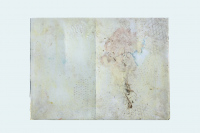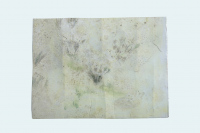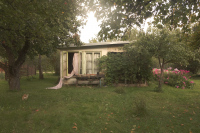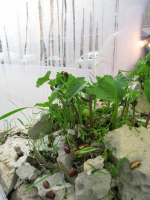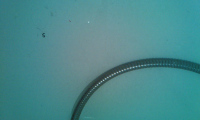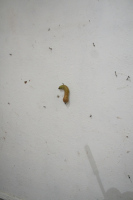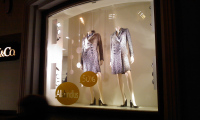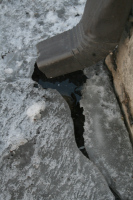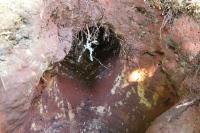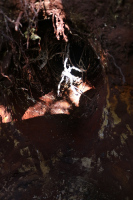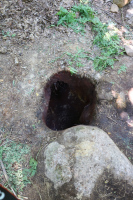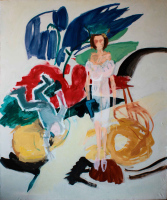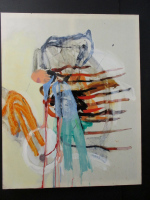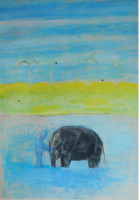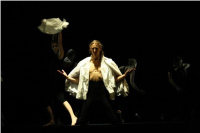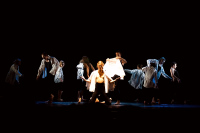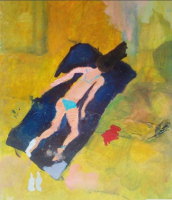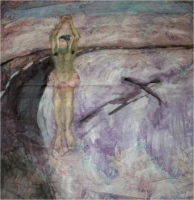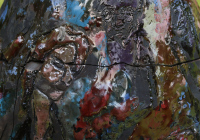
“Unknown Artist from Salaspils”
Detail, glazed vases
Due to its strategically advantageous location, Salaspils and its inhabitants have frequently and heavily suffered from ongoing wars. What would have been the history of Salaspils and the people of Salaspils in the 14th - 17th centuries if they lived in more peaceful times? Would it have affected local art? There is not much archaeological evidence for this period, but it is presumed that the local artists continued to draw ornaments, as in earlier periods.
In search of an alternative history where Salaspils inhabitants, despite historical conditions, have been able to sometimes express themselves in art, excavations led by archaeologist A. Dimina were carried out. In the vicinity of Salaskalns estate (present-day Saulkalne town area), well-preserved vases and pots were found dating from the 14th–17th centuries. Examination of the dishes shows that they are made of local clay and painted with glazes probably bought from the Germans.
The theme of the dishes indicates the cult of animalism in the territory of Latvia. The rendering of human figures in static poses is also characteristic of the art of the time elsewhere in the Baltic Sea basin.

“Unknown Artist from Salaspils”
Instalation view, glazed vases
Due to its strategically advantageous location, Salaspils and its inhabitants have frequently and heavily suffered from ongoing wars. What would have been the history of Salaspils and the people of Salaspils in the 14th - 17th centuries if they lived in more peaceful times? Would it have affected local art? There is not much archaeological evidence for this period, but it is presumed that the local artists continued to draw ornaments, as in earlier periods.
In search of an alternative history where Salaspils inhabitants, despite historical conditions, have been able to sometimes express themselves in art, excavations led by archaeologist A. Dimina were carried out. In the vicinity of Salaskalns estate (present-day Saulkalne town area), well-preserved vases and pots were found dating from the 14th–17th centuries. Examination of the dishes shows that they are made of local clay and painted with glazes probably bought from the Germans.
The theme of the dishes indicates the cult of animalism in the territory of Latvia. The rendering of human figures in static poses is also characteristic of the art of the time elsewhere in the Baltic Sea basin.

“Unknown Artist from Salaspils”
Instalation view, glazed vases
Due to its strategically advantageous location, Salaspils and its inhabitants have frequently and heavily suffered from ongoing wars. What would have been the history of Salaspils and the people of Salaspils in the 14th - 17th centuries if they lived in more peaceful times? Would it have affected local art? There is not much archaeological evidence for this period, but it is presumed that the local artists continued to draw ornaments, as in earlier periods.
In search of an alternative history where Salaspils inhabitants, despite historical conditions, have been able to sometimes express themselves in art, excavations led by archaeologist A. Dimina were carried out. In the vicinity of Salaskalns estate (present-day Saulkalne town area), well-preserved vases and pots were found dating from the 14th–17th centuries. Examination of the dishes shows that they are made of local clay and painted with glazes probably bought from the Germans.
The theme of the dishes indicates the cult of animalism in the territory of Latvia. The rendering of human figures in static poses is also characteristic of the art of the time elsewhere in the Baltic Sea basin.
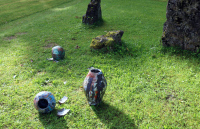
“Unknown Artist from Salaspils”
Instalation view, glazed vases
Due to its strategically advantageous location, Salaspils and its inhabitants have frequently and heavily suffered from ongoing wars. What would have been the history of Salaspils and the people of Salaspils in the 14th - 17th centuries if they lived in more peaceful times? Would it have affected local art? There is not much archaeological evidence for this period, but it is presumed that the local artists continued to draw ornaments, as in earlier periods.
In search of an alternative history where Salaspils inhabitants, despite historical conditions, have been able to sometimes express themselves in art, excavations led by archaeologist A. Dimina were carried out. In the vicinity of Salaskalns estate (present-day Saulkalne town area), well-preserved vases and pots were found dating from the 14th–17th centuries. Examination of the dishes shows that they are made of local clay and painted with glazes probably bought from the Germans.
The theme of the dishes indicates the cult of animalism in the territory of Latvia. The rendering of human figures in static poses is also characteristic of the art of the time elsewhere in the Baltic Sea basin.
-
1
“Unknown Artist from Salaspils”
Detail, glazed vases
Due to its strategically advantageous location, Salaspils and its inhabitants have frequently and heavily suffered from ongoing wars. What would have been the history of Salaspils and the people of Salaspils in the 14th - 17th centuries if they lived in more peaceful times? Would it have affected local art? There is not much archaeological evidence for this period, but it is presumed that the local artists continued to draw ornaments, as in earlier periods.
In search of an alternative history where Salaspils inhabitants, despite historical conditions, have been able to sometimes express themselves in art, excavations led by archaeologist A. Dimina were carried out. In the vicinity of Salaskalns estate (present-day Saulkalne town area), well-preserved vases and pots were found dating from the 14th–17th centuries. Examination of the dishes shows that they are made of local clay and painted with glazes probably bought from the Germans.
The theme of the dishes indicates the cult of animalism in the territory of Latvia. The rendering of human figures in static poses is also characteristic of the art of the time elsewhere in the Baltic Sea basin.
-
2
“Unknown Artist from Salaspils”
Instalation view, glazed vases
Due to its strategically advantageous location, Salaspils and its inhabitants have frequently and heavily suffered from ongoing wars. What would have been the history of Salaspils and the people of Salaspils in the 14th - 17th centuries if they lived in more peaceful times? Would it have affected local art? There is not much archaeological evidence for this period, but it is presumed that the local artists continued to draw ornaments, as in earlier periods.
In search of an alternative history where Salaspils inhabitants, despite historical conditions, have been able to sometimes express themselves in art, excavations led by archaeologist A. Dimina were carried out. In the vicinity of Salaskalns estate (present-day Saulkalne town area), well-preserved vases and pots were found dating from the 14th–17th centuries. Examination of the dishes shows that they are made of local clay and painted with glazes probably bought from the Germans.
The theme of the dishes indicates the cult of animalism in the territory of Latvia. The rendering of human figures in static poses is also characteristic of the art of the time elsewhere in the Baltic Sea basin.
-
3
“Unknown Artist from Salaspils”
Instalation view, glazed vases
Due to its strategically advantageous location, Salaspils and its inhabitants have frequently and heavily suffered from ongoing wars. What would have been the history of Salaspils and the people of Salaspils in the 14th - 17th centuries if they lived in more peaceful times? Would it have affected local art? There is not much archaeological evidence for this period, but it is presumed that the local artists continued to draw ornaments, as in earlier periods.
In search of an alternative history where Salaspils inhabitants, despite historical conditions, have been able to sometimes express themselves in art, excavations led by archaeologist A. Dimina were carried out. In the vicinity of Salaskalns estate (present-day Saulkalne town area), well-preserved vases and pots were found dating from the 14th–17th centuries. Examination of the dishes shows that they are made of local clay and painted with glazes probably bought from the Germans.
The theme of the dishes indicates the cult of animalism in the territory of Latvia. The rendering of human figures in static poses is also characteristic of the art of the time elsewhere in the Baltic Sea basin.
-
4
“Unknown Artist from Salaspils”
Instalation view, glazed vases
Due to its strategically advantageous location, Salaspils and its inhabitants have frequently and heavily suffered from ongoing wars. What would have been the history of Salaspils and the people of Salaspils in the 14th - 17th centuries if they lived in more peaceful times? Would it have affected local art? There is not much archaeological evidence for this period, but it is presumed that the local artists continued to draw ornaments, as in earlier periods.
In search of an alternative history where Salaspils inhabitants, despite historical conditions, have been able to sometimes express themselves in art, excavations led by archaeologist A. Dimina were carried out. In the vicinity of Salaskalns estate (present-day Saulkalne town area), well-preserved vases and pots were found dating from the 14th–17th centuries. Examination of the dishes shows that they are made of local clay and painted with glazes probably bought from the Germans.
The theme of the dishes indicates the cult of animalism in the territory of Latvia. The rendering of human figures in static poses is also characteristic of the art of the time elsewhere in the Baltic Sea basin.
“Unknown Artist from Salaspils”
instalation view, glazed vases
2022
"thieves visiting the garden house"
Dārziņi, Latvia
oil on carboard, found footprint and instalation,
0.5 x 0.35 m, 2012
"no birches inside me vol.2"
Tallinn, Estonia
gypsium, seeds, 1 x 1 x 0.7m, 2013
w Elīna Vītola

Founding the Elephant
Concrete
In 1950 Maurice Hercog led the expedition to the Annapurna northern wall, thus reaching the first eight-thousander in history. The conquering of all 14 world highest peaks concluded with the final peak – Shishapangma in 1964.
Explorer 6, the first satellite to make photos of the Earth, was sent into space in 1959. Since then there is no single square meter of the Earth left, which couldn’t be found on Google maps. No island in Pacific Ocean. The fifth part of the bottom of the sea is explored as well, with the complete mapping set to be finished around 2030.
When the world was young, there was a lot of uninhabited islands to reveal. But, given the ever-increasing rate of discovery and the fact that every next explorer needs to dig-out even more, can one still find a meadow, where the world is young?
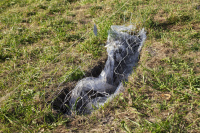
Founding the Elephant
Concrete
In 1950 Maurice Hercog led the expedition to the Annapurna northern wall, thus reaching the first eight-thousander in history. The conquering of all 14 world highest peaks concluded with the final peak – Shishapangma in 1964.
Explorer 6, the first satellite to make photos of the Earth, was sent into space in 1959. Since then there is no single square meter of the Earth left, which couldn’t be found on Google maps. No island in Pacific Ocean. The fifth part of the bottom of the sea is explored as well, with the complete mapping set to be finished around 2030.
When the world was young, there was a lot of uninhabited islands to reveal. But, given the ever-increasing rate of discovery and the fact that every next explorer needs to dig-out even more, can one still find a meadow, where the world is young?
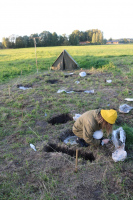
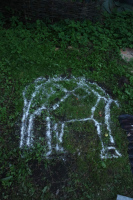
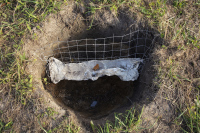
Founding the Elephant
Concrete
In 1950 Maurice Hercog led the expedition to the Annapurna northern wall, thus reaching the first eight-thousander in history. The conquering of all 14 world highest peaks concluded with the final peak – Shishapangma in 1964.
Explorer 6, the first satellite to make photos of the Earth, was sent into space in 1959. Since then there is no single square meter of the Earth left, which couldn’t be found on Google maps. No island in Pacific Ocean. The fifth part of the bottom of the sea is explored as well, with the complete mapping set to be finished around 2030.
When the world was young, there was a lot of uninhabited islands to reveal. But, given the ever-increasing rate of discovery and the fact that every next explorer needs to dig-out even more, can one still find a meadow, where the world is young?
-
1
Founding the Elephant
Concrete
In 1950 Maurice Hercog led the expedition to the Annapurna northern wall, thus reaching the first eight-thousander in history. The conquering of all 14 world highest peaks concluded with the final peak – Shishapangma in 1964.
Explorer 6, the first satellite to make photos of the Earth, was sent into space in 1959. Since then there is no single square meter of the Earth left, which couldn’t be found on Google maps. No island in Pacific Ocean. The fifth part of the bottom of the sea is explored as well, with the complete mapping set to be finished around 2030.
When the world was young, there was a lot of uninhabited islands to reveal. But, given the ever-increasing rate of discovery and the fact that every next explorer needs to dig-out even more, can one still find a meadow, where the world is young?
-
2
Founding the Elephant
Concrete
In 1950 Maurice Hercog led the expedition to the Annapurna northern wall, thus reaching the first eight-thousander in history. The conquering of all 14 world highest peaks concluded with the final peak – Shishapangma in 1964.
Explorer 6, the first satellite to make photos of the Earth, was sent into space in 1959. Since then there is no single square meter of the Earth left, which couldn’t be found on Google maps. No island in Pacific Ocean. The fifth part of the bottom of the sea is explored as well, with the complete mapping set to be finished around 2030.
When the world was young, there was a lot of uninhabited islands to reveal. But, given the ever-increasing rate of discovery and the fact that every next explorer needs to dig-out even more, can one still find a meadow, where the world is young?
- 3
- 4
-
5
Founding the Elephant
Concrete
In 1950 Maurice Hercog led the expedition to the Annapurna northern wall, thus reaching the first eight-thousander in history. The conquering of all 14 world highest peaks concluded with the final peak – Shishapangma in 1964.
Explorer 6, the first satellite to make photos of the Earth, was sent into space in 1959. Since then there is no single square meter of the Earth left, which couldn’t be found on Google maps. No island in Pacific Ocean. The fifth part of the bottom of the sea is explored as well, with the complete mapping set to be finished around 2030.
When the world was young, there was a lot of uninhabited islands to reveal. But, given the ever-increasing rate of discovery and the fact that every next explorer needs to dig-out even more, can one still find a meadow, where the world is young?
"Finding Elephant"
excavation - installation, parts of concrete sculpture, various size, 2021
no birches inside me, preperation
gypsium, seeds, 1 x 0.7 x 0.3 m , 2012
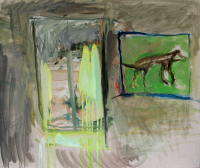
wolf/dog
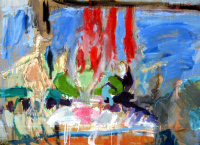
breakfast in Hamburg
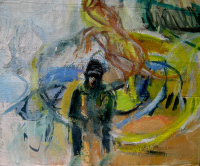
Bremen

asking protection on my way home
in France
cave art. Sippola, Finland
inverted sculpture, self made oil colour
made from native earth coloured with hydrated
iron oxide mixed with oil. 0.7 x 0.7 x 1.7m, 2020
"cold calm day nothing can be killed"
oil on canvas, 1.5 x 1.2 m, 1.2 x 1 m, 0,9 x 0.6 m, 2012
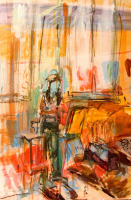
paju
oil on cardboard, 0.7 x 0.4 m
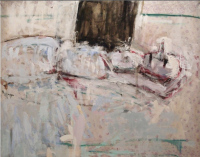
selfportrait
oil on canvas, 1.5 x 1.2 m

juliet
oil on canvas, 1.5 x 1.2 m
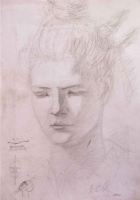
sister
pencil on paper, 0.6 x 0.4 m

mother
pencil on paper, 0.7 x 0.45 m
portraits

wolf
oil on canvas, 1.3 x 0.9 m
-
1
wolf
oil on canvas, 1.3 x 0.9 m
animals

glass-house in Firstschool
-
1
glass-house in Firstschool
landscapes
